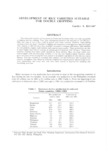Development of Rice Varieties Suitable for Double Cropping
Tropical agriculture research series : proceedings of a symposium on tropical agriculture researches
| ISSN | 03889386 |
|---|---|
| NII recode ID (NCID) | AA00870529 |

Full text
tars20-_235-246.pdf1.69 MB
The traditional varieties of rice grown in South and Southeast Asia were tall, susceptible to lodging and low-yielding. They were photoperiod-sensitive and matured in 170-190 days. Only one crop of rice a year could be grown with these varieties. However, high-yielding varieties which are short, resistant to lodging and responsive to nitrogen have been developed. They mature in 100-100 days, have multiple resistance to diseases and insects, and tolerance for soil problems, higher yield stability and superior grain quality. Their productivity per day is much higher than that of varieties of medium growth duration (130-140 days). These short duration varieties have been widely adopted by Asian farmers. Most rice areas which were mono-cropped with late-maturing varieties of rice are now double-cropped. Farmers either grow two crops of rice during the rainy season or an upland crop before or after the rice crop is planted. This has resulted in increased food supplies, rice self-sufficiency and increased food security throughout Asia. Adoption of double cropping has created greater opportunities for on-farm employment and many new jobs have been created in post-harvest handling and
marketing activities.
marketing activities.
| Date of issued | |
|---|---|
| Creator | Gurdev S. KHUSH |
| Publisher | Japan International Research Center for Agricultural Sciences |
| Volume | 20 |
| spage | 235 |
| epage | 246 |
| Language | eng |
